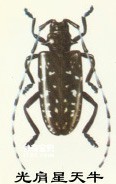The larvae of the beetle live in the trunk of the tree and bore out the trunk, making the tree easy to break, so people call it the "tree-sawing man". The "Three North" protective forest is our country's green Great Wall that prevents wind and fixes sand. It is dominated by poplar trees. Star beetle is the main pest of poplar trees, often causing wind damage and death of poplar trees.

Adult: 17-39 mm in length, jet black with coppery sheen. There are wrinkles and points on the pronotum, and there is a spinous protrusion on each side. There are more than a dozen white spots on the elytra, the base is smooth, and there are no tumor-like particles.
Egg: 5.5 mm long, oblong, slightly curved, milky white; the eggs seen under the bark are mostly light yellowish brown, slightly flat, and nearly cucumber seed-shaped.
Larvae: 50-60 mm in length, milky white, legless, with convex lines on the pronotum.
Pupa: Body length 30 mm, naked pupa, yellowish white.
Life history and habits: One generation occurs every year, or one generation occurs every two years. Overwinter as larvae or eggs. When the temperature rises above 10 degrees Celsius in April next year, the overwintering larvae begin to cause damage. The period from early May to late June is the pupation period of the larvae. It takes about 41 days from making a pupa chamber to emerging into an adult. Adult beetles begin to appear in early June, and the peak period is from late June to late July, with adult beetles active until October. Adults begin to lay eggs in mid-June, and July and August are the peak egg-laying periods, with the egg period lasting about 16 days. Larvae begin to appear at the end of June, and by November the temperature drops below 6 degrees Celsius, and they begin to overwinter. The white beetle mainly damages trees such as poplar, poplar, poplar, dry willow and weeping willow. The larvae feed on tree trunks, which can cause mild damage to the wood quality, but serious damage can cause tree dieback and wind damage; the adults eat the bark and xylem of leaves or twigs, have weak flying power, and mostly mate on tree trunks during the day. Before laying eggs, the female gnaws a small groove in the bark, digs an egg-laying hole in the groove, and then lays one egg (some two) in each groove. A female adult usually lays about 30 eggs. The grooved parts are mostly on the trunks with a thickness of 3-6 cm, especially the parts with concentrated side branches and large decentralization. The bigger the tree, the higher the grooved part. The newly hatched larvae first feed between the bark and the xylem. After 25-30 days, they begin to bore into the xylem and feed upward. Insect tunnels are generally 90 mm long, with the longest reaching 150 mm. After the larvae penetrate the xylem, they often return to the outside of the xylem to feed on sapwood and bast.
Control methods: Adult insects can be caught during their peak bloom period, or pesticides can be sprayed and holes plugged. Protecting and utilizing natural enemies is an effective method of control. Woodpeckers are the main natural enemies of beetles and should be actively protected and attracted. Generally, a pair of woodpeckers in 500 acres of woodland can suppress the occurrence of beetles. The method of attracting is: hang an attracting tree every 150 meters or so in the forest in autumn. The attraction wood should be made of soft and rotten wood sections, 60 cm long and 20 cm thick, with a wooden cover nailed to the top to prevent rainwater from flowing in.
animal tags:
We created this article in conjunction with AI technology, then made sure it was fact-checked and edited by a Animals Top editor.